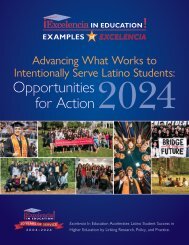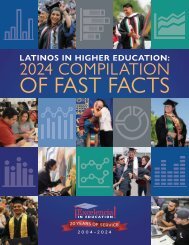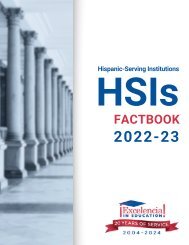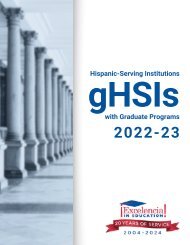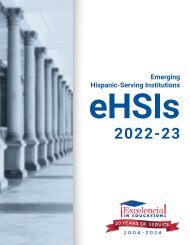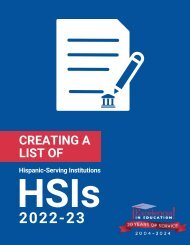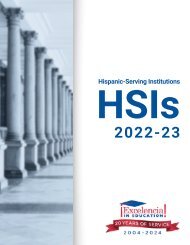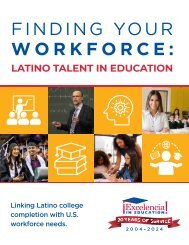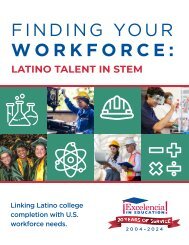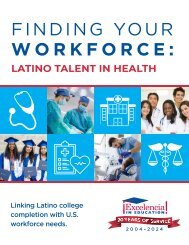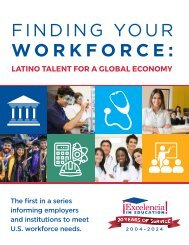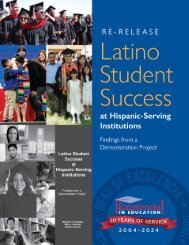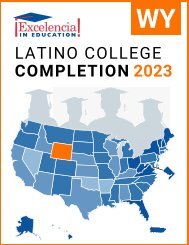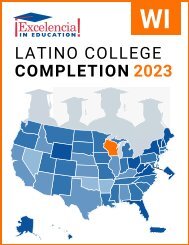Latino College Completion 2023: Massachusetts
You also want an ePaper? Increase the reach of your titles
YUMPU automatically turns print PDFs into web optimized ePapers that Google loves.
MA
LATINO COLLEGE COMPLETION:<br />
MASSACHUSETTS – <strong>2023</strong><br />
For the U.S. to regain the top ranking in the world for college degree<br />
attainment, <strong>Latino</strong>s will need to earn 6.2 million degrees by 2030. 1<br />
FAST FACTS<br />
STATE RANKING:<br />
<strong>Massachusetts</strong> had the 15th largest<br />
<strong>Latino</strong> population in the U.S.<br />
K-12 POPULATION:<br />
In <strong>Massachusetts</strong>, 19% of the K-12<br />
population was <strong>Latino</strong>. 2<br />
POPULATION:<br />
In <strong>Massachusetts</strong>, 13% of the<br />
population was <strong>Latino</strong>. 2<br />
MEDIAN AGE:<br />
The median age<br />
of Hispanics in<br />
<strong>Massachusetts</strong> was<br />
29, compared<br />
to 45 for White<br />
non-Hispanics. 2<br />
29<br />
Hispanics<br />
45<br />
White<br />
non-Hispanics<br />
ENROLLMENT:<br />
In <strong>Massachusetts</strong>, 22% of<br />
Hispanics (ages 18 to 34) were<br />
enrolled in higher education, compared<br />
to 29% of White non-Hispanics. 2<br />
DEGREE ATTAINMENT:<br />
In <strong>Massachusetts</strong>, 29% of Hispanic<br />
adults (25 and older) had earned an<br />
associate degree or higher, compared to<br />
58% of White non-Hispanic adults. 2<br />
Hispanic Adults = 2.9 of 10<br />
To reach the degree attainment goal by 2030, the U.S. can: close<br />
the degree completion gap by accelerating <strong>Latino</strong> completion while<br />
increasing for all students and scale up programs and initiatives that<br />
work for <strong>Latino</strong>, and all, students. The following demographics,<br />
institutional data, and practices inform <strong>Latino</strong> degree attainment.<br />
ENROLLING: Top 5 Institutions (Hispanic Undergraduates) in <strong>Massachusetts</strong>, 2021-22<br />
Institution<br />
Sector<br />
Grand<br />
Total<br />
NOTE: We use the terms <strong>Latino</strong> and Hispanic interchangeably in this factsheet.<br />
Hispanic<br />
Total<br />
Source: Excelencia in Education analysis using U.S. Department of Education, National Center for<br />
Education Statistics (NCES), Integrated Postsecondary Education Data System (IPEDS), 2021 Fall<br />
Enrollment, Graduation Rates Survey and Institutional Characteristics Survey.<br />
%<br />
Hispanic<br />
1 Bunker Hill Community <strong>College</strong> Public, 2-year 8,006 2,319 29%<br />
2 University of <strong>Massachusetts</strong>-Boston Public, 4-year 11,949 2,259 19%<br />
3 University of <strong>Massachusetts</strong>-Amherst Public, 4-year 23,947 2,048 9%<br />
Private not-forprofit,<br />
4-year<br />
4 Boston University<br />
17,501 1,881 11%<br />
5 Northern Essex Community <strong>College</strong> Public, 2-year 3,884 1,788 46%<br />
ASSOCIATE DEGREES: Top 5 Institutions Awarding to Hispanics in <strong>Massachusetts</strong>, 2020-21<br />
Institution<br />
Sector<br />
Grand<br />
Total<br />
Hispanic<br />
Total<br />
%<br />
Hispanic<br />
1 Bunker Hill Community <strong>College</strong> Public, 2-year 1,173 290 25%<br />
2 Springfield Technical Community <strong>College</strong> Public, 2-year 780 186 24%<br />
3 Northern Essex Community <strong>College</strong> Public, 2-year 478 159 33%<br />
4 North Shore Community <strong>College</strong> Public, 2-year 719 157 22%<br />
5 Middlesex Community <strong>College</strong> Public, 2-year 881 141 16%<br />
BACHELOR DEGREES: Top 5 Institutions Awarding to Hispanics in <strong>Massachusetts</strong>, 2020-21<br />
Institution<br />
Sector<br />
Grand<br />
Total<br />
Hispanic<br />
Total<br />
%<br />
Hispanic<br />
Private not-forprofit,<br />
4-year<br />
1 Boston University<br />
4,417 517 12%<br />
2 University of <strong>Massachusetts</strong>-Amherst Public, 4-year 5,970 422 7%<br />
3 University of <strong>Massachusetts</strong>-Boston Public, 4-year 2,674 415 16%<br />
4 University of <strong>Massachusetts</strong>-Lowell Public, 4-year 3,111 387 12%<br />
Private not-forprofit,<br />
4-year<br />
5 Northeastern University<br />
4,295 316 7%<br />
White Adults = 5.8 of 10<br />
1 Projections to 2030: Excelencia in Education. (2020). Ensuring America’s Future: Benchmarking <strong>Latino</strong><br />
<strong>College</strong> <strong>Completion</strong> to 2030. Excelencia in Education. Washington, D.C.<br />
2 U.S. Census Bureau, 2021 American Community Survey 1-Year Estimates
<strong>Massachusetts</strong> Gap in Degree <strong>Completion</strong><br />
Closing the degree completion gap can be tracked<br />
by the 4 measures shown below. Alone, none<br />
of these measures capture the entire “story” of<br />
degree completion. However, in combination,<br />
they provide a useful picture of the gap in degree<br />
attainment between Hispanic and White non-<br />
Hispanic cohorts in a single year.<br />
Graduation Rate — Total percentage of students<br />
who graduated within 150% of normal time for<br />
first-time, full-time freshmen. This incorporates<br />
students that graduated in 3 years at two-year<br />
institutions, or in 6 years at four-year institutions.<br />
Transferred to Another Institution —<br />
Percentage of students that transferred to another<br />
institution and did not complete a degree.<br />
Still Enrolled — Percentage of students that are<br />
still enrolled at the point of 150% normal time to<br />
completion.<br />
No Longer Enrolled — Percentage of students<br />
that are no longer enrolled at the point of 150%<br />
normal time to completion.<br />
At two-year institutions, Hispanics’<br />
graduation rate was 11%-points<br />
lower than that of their White non-<br />
Hispanic peers in <strong>Massachusetts</strong>.<br />
TWO-YEAR INSTITUTIONS<br />
45%<br />
14%<br />
17%<br />
25%<br />
WHITE<br />
-11%<br />
58%<br />
17%<br />
11%<br />
14%<br />
HISPANIC<br />
DEGREE OUTCOMES<br />
■ No Longer Enrolled<br />
■ Still Enrolled<br />
■ Transferred to<br />
Another Institution<br />
■ Graduation Rate<br />
*Percentages may not add up to 100% due to rounding.<br />
At four-year institutions,<br />
Hispanics’ graduation rate was<br />
9%-points lower than that of<br />
their White non-Hispanic peers in<br />
<strong>Massachusetts</strong>.<br />
FOUR-YEAR INSTITUTIONS<br />
1%<br />
13%<br />
9%<br />
77%<br />
WHITE<br />
1%<br />
-9%<br />
18%<br />
12%<br />
68%<br />
HISPANIC<br />
NOTE: Outcomes shown are for students at two-year institutions who started in Fall 2018, and<br />
for students at four-year institutions who started in Fall 2015.<br />
Source: Excelencia in Education analysis using the U.S. Department of Education, National<br />
Center for Education Statistics (NCES), Integrated Postsecondary Education Data System, 2021<br />
Graduation Rates Survey and the Institutional Characteristics Survey.<br />
Examples of What Works for <strong>Latino</strong> Students<br />
There are institutions showing success in enrolling, retaining, and graduating <strong>Latino</strong> students. The following are examples of<br />
programs across the country with evidence of effectiveness in serving <strong>Latino</strong> students nominated for Examples of Excelencia.<br />
The Latinx Leadership Initiative (LLI) at Boston <strong>College</strong> trains and<br />
supports <strong>Latino</strong>, bilingual MSW and PhD students to transform how the<br />
social work profession works with Latinx communities in the United<br />
States. LLI’s goal is to increase the number of <strong>Latino</strong> social workers in the<br />
U.S. and develop social work leaders equipped to work effectively with<br />
the <strong>Latino</strong> community. Established in 2013, LLI was designed to meet the<br />
needs of a growing Latinx population in the U.S. Currently, fewer than<br />
5 percent of social workers in the U.S. are Latinx. Research shows that<br />
social work services that are language and ethnic concordant are the<br />
most beneficial for Latinx communities. However, the dismal number of<br />
Latinx social workers in the U.S. cannot meet the current needs of Latinx<br />
communities. As a result, many Latinx communities receive services from<br />
non-Latinx social workers who do not understand Latinx culture. LLI offers<br />
its participants a cohort-based learning model emphasizing a paradigm of<br />
cultural capital among the Latinx community. Together, all LLI students<br />
take 8 Master’s in Social Work core classes in Spanish, allowing students<br />
to develop professional proficiency in Spanish required to work with<br />
Latinx communities and create an academic space in which the assets of<br />
Latinx culture can flourish. Students are also offered internship placements<br />
supervised by LLI alumni that allow students to work closely with Latinx<br />
communities and require them to use their bilingual background. Faculty<br />
and LLI advisors, who themselves are bilingual Latinxs and are often LLI<br />
alumni, serve as mentors to program participants.<br />
Of program graduates, 100% have secured full-time positions and many<br />
are now in leadership positions informing practice and serving their<br />
community. LLI has established a network of 148 <strong>Latino</strong> alumni across<br />
23 states that support current students as advisors and mentors. A<br />
substantial proportion of LLI participants have received competitive<br />
awards including the national Council of Social Work Education’s<br />
Minority Fellowship. In just the last two years, 9 LLI students have<br />
received this coveted fellowship aimed at increasing the number of<br />
individuals trained to work with underserved ethno-racial minorities at<br />
risk for mental health and/or substance abuse disorders.<br />
For more information on institutional programs improving <strong>Latino</strong> student success in higher education, access Excelencia in<br />
Education’s Growing What Works database at http://www.edexcelencia.org/growing-what-works<br />
ENSURING AMERICA’S FUTURE BY INCREASING LATINO COLLEGE COMPLETION • WWW.EDEXCELENCIA.ORG




